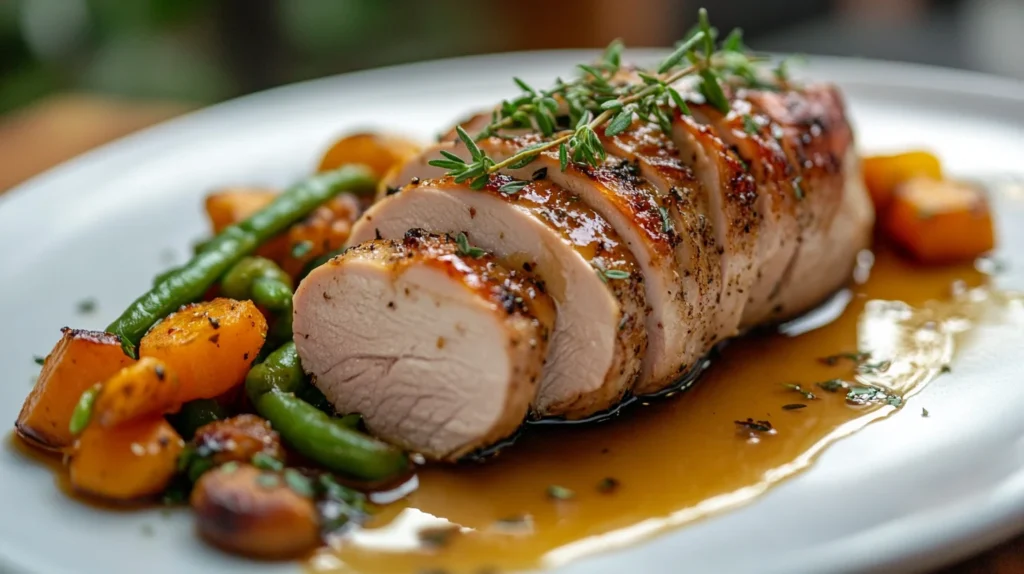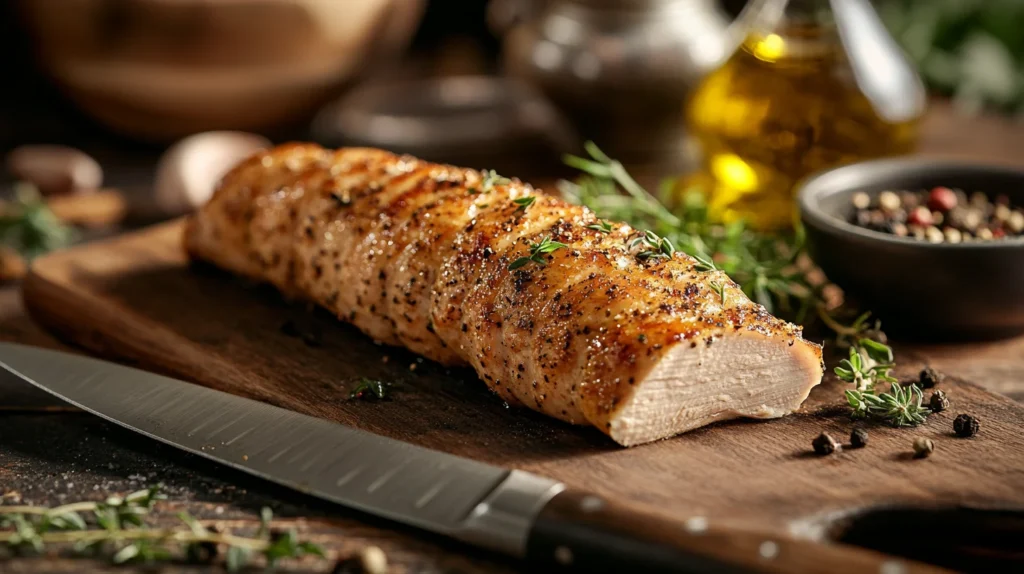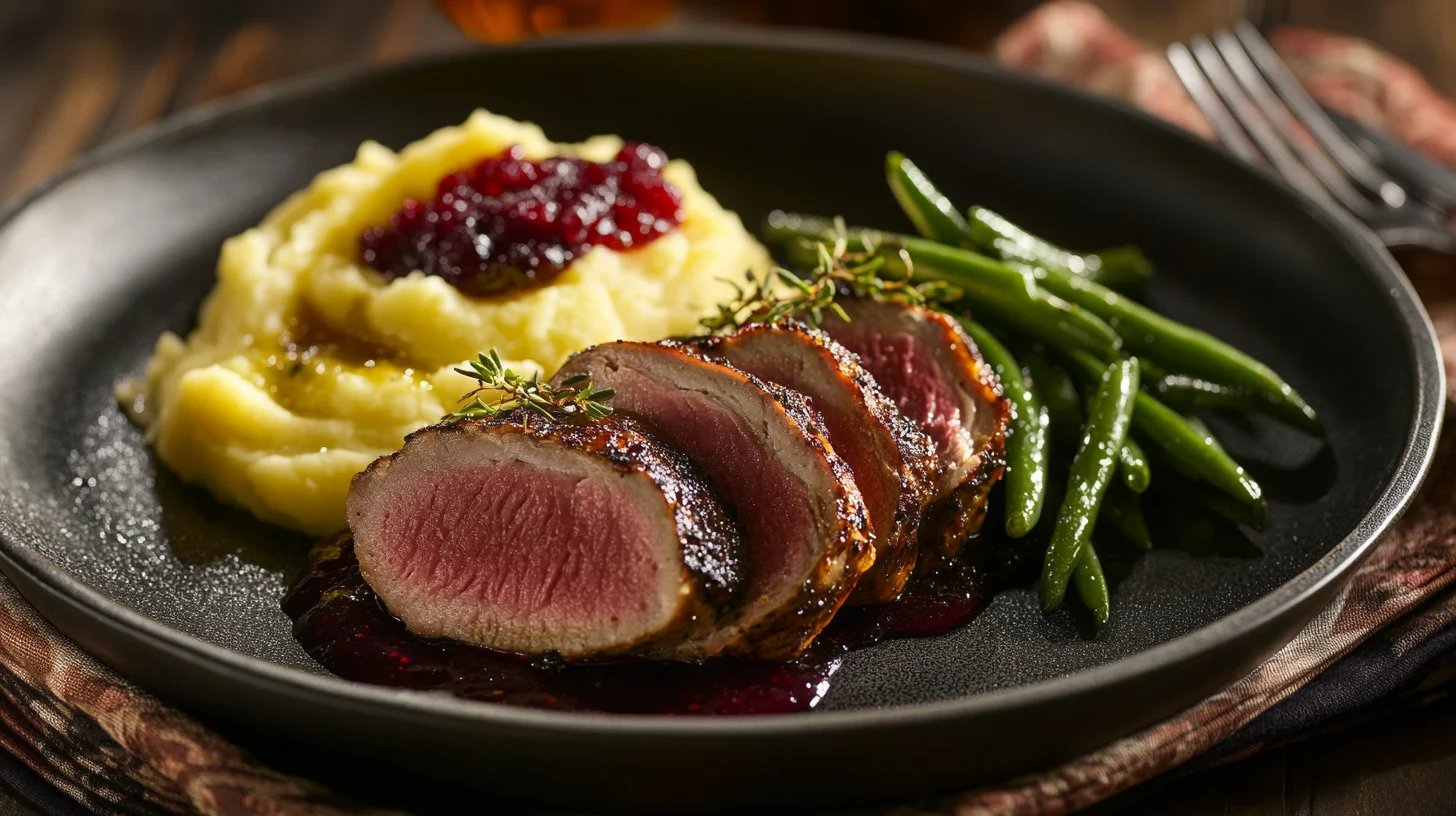Last updated on May 10th, 2025
Turkey tenderloin is a lean and flavorful cut of meat that’s perfect for quick weeknight dinners or special occasions. This Turkey Tenderloin Recipe showcases its versatility, allowing you to prepare it through roasting, grilling, or slow cooking. Whether you’re planning a cozy family meal or a holiday feast, turkey tenderloin offers a healthy and satisfying option. For more creative recipe ideas, explore this Cherry Cheesecake Recipe for dessert.
Packed with protein and low in fat, turkey tenderloin is an excellent choice for those following keto, paleo, or low-carb diets. Its mild flavor makes it the perfect base for various seasonings and marinades. Pair this recipe with side dishes like Baked Beans with Ground Beef for a hearty and balanced meal. Whether you’re an experienced chef or a home cook looking to try something new, this guide will help you create a tenderloin that’s moist, flavorful, and unforgettable.
Table of contents
Ingredients You’ll Need
Core Ingredients
- Turkey Tenderloin: This lean cut of meat is the star of the dish, offering a tender texture and mild flavor that’s perfect for absorbing seasonings.
- Olive Oil: Helps lock in moisture while creating a light, flavorful crust.
- Fresh Garlic: Adds depth and enhances the savory notes of the turkey.
- Herbs: Rosemary, thyme, and parsley provide aromatic flavors that elevate the dish.
- Salt and Pepper: Simple yet essential seasonings to enhance the natural flavors.
Optional Add-Ins
- Lemon Juice: A touch of acidity brightens the overall flavor and helps tenderize the meat.
- Paprika or Cayenne: Adds a smoky or spicy kick, perfect for those who like bold flavors.
- Marinade: A blend of honey, soy sauce, and mustard can enhance the turkey’s flavor while keeping it moist and tender.
Pro Tip:
For maximum flavor, always season or marinate the turkey tenderloin in advance. Let it sit in the refrigerator for at least 30 minutes or overnight to allow the spices and marinades to fully penetrate the meat.

Step-by-Step Instructions
1. Prepare the Turkey Tenderloin
Start by patting the turkey tenderloin dry with a paper towel. This step is essential to remove excess moisture, which helps the seasoning stick better and promotes even browning during cooking. If you’re planning to marinate the turkey, ensure it’s trimmed of any excess fat before placing it in the marinade.
2. Season Generously
Drizzle the tenderloin with olive oil, then rub it with minced garlic, fresh herbs, salt, and pepper. For a flavor boost, you can use your favorite seasoning blends such as Italian herbs or Cajun spices. If you’re using a marinade, place the tenderloin in a zip-lock bag with the marinade, ensuring it’s fully coated. Let it rest in the refrigerator for 30 minutes to 24 hours.
3. Choose Your Cooking Method
Oven Roasting
- Preheat the oven to 375°F (190°C).
- Place the tenderloin on a baking sheet lined with parchment paper or in a roasting pan.
- Roast for 25–30 minutes or until the internal temperature reaches 165°F (74°C).
Grilling
- Preheat the grill to medium heat.
- Cook the tenderloin for 10–12 minutes per side, turning occasionally for even cooking.
- Use a meat thermometer to ensure it reaches an internal temperature of 165°F.
Slow Cooking
- Place the seasoned tenderloin in a crockpot with broth or your choice of marinade.
- Cook on low for 4–5 hours, or until the meat is tender and juicy.
4. Rest and Slice
Once the tenderloin is cooked, remove it from the heat and let it rest for 5–10 minutes. Resting allows the juices to redistribute throughout the meat, resulting in a moist and flavorful dish. Slice the tenderloin into medallions or thick slices, depending on your preference, and serve with your favorite sides.
Flavor Variations
1. Garlic Herb Turkey Tenderloin
Rub the tenderloin with a mixture of minced garlic, rosemary, thyme, and parsley for a classic flavor profile. Serve with roasted vegetables or a fresh green salad for a light, satisfying meal.
2. Honey Mustard Glaze
Combine honey, Dijon mustard, and soy sauce to create a sweet and tangy glaze. Brush it over the tenderloin before roasting or grilling for a caramelized crust that pairs beautifully with mashed potatoes or rice.
3. Cajun-Spiced Turkey Tenderloin
For a bold and smoky twist, rub the tenderloin with a blend of paprika, cayenne pepper, garlic powder, and onion powder. Serve with cornbread or a side of dirty rice for a Southern-inspired meal.
4. Cranberry Orange Marinade
Mix cranberry sauce, orange juice, and a pinch of cinnamon for a holiday-inspired flavor. This sweet and tangy marinade makes the tenderloin a perfect centerpiece for festive gatherings.
Serving Suggestions
- Pair the tenderloin with creamy mashed potatoes, roasted Brussels sprouts, or a crisp Caesar salad.
- Drizzle it with a savory gravy or a fresh chimichurri sauce for added flavor.
- Use leftovers to make turkey sandwiches, wraps, or grain bowls with quinoa and roasted vegetables.
- Serve alongside Cottage Cheese Flatbread for a unique and satisfying side.
Storage and Reheating Tips
- Refrigeration: Store cooked turkey tenderloin in an airtight container for up to 3 days.
- Freezing: Wrap the tenderloin tightly in plastic wrap and store in a freezer-safe bag for up to 3 months.
- Reheating: Preheat the oven to 300°F and add a splash of broth or water to keep the meat moist while reheating.

FAQs About Turkey Tenderloin
Turkey tenderloin is a versatile and delicious protein that can be prepared in various ways. Here are answers to some common questions to help you cook it perfectly and understand its uses.
What is turkey tenderloin good for?
Turkey tenderloin is ideal for quick, healthy meals because it cooks faster than other turkey cuts while remaining lean and tender. It’s perfect for grilling, roasting, or slow cooking and works well with various seasonings and marinades. This cut is excellent for dishes like turkey medallions, stir-fries, or as the centerpiece of a meal paired with sides like roasted vegetables or mashed potatoes. It’s also a great alternative to chicken or pork for those seeking a lower-fat option.
Is turkey tenderloin the same as turkey breast?
Turkey tenderloin is a specific part of the turkey breast. It’s the boneless, skinless muscle that lies under the main part of the breast. It’s smaller, more tender, and quicker to cook than the full breast, making it a great choice for recipes requiring lean protein without the hassle of dealing with bones or skin.
How long is cooked turkey tenderloin good for?
Cooked turkey tenderloin can be stored in the refrigerator for up to 3–4 days if kept in an airtight container. For longer storage, freeze the cooked tenderloin in a freezer-safe bag or container for up to 3 months. When reheating, add a splash of broth or water to maintain moisture.
How to tell if turkey tenderloin is cooked?
The best way to tell if turkey tenderloin is cooked is by using a meat thermometer. Insert the thermometer into the thickest part of the meat; it should read 165°F (74°C), which is the USDA’s recommended safe internal temperature for poultry. If you don’t have a thermometer, cut into the thickest part of the tenderloin—it should be white with no pink remaining, and the juices should run clear.
What is the difference between turkey tenderloin and turkey breast?
While both cuts come from the breast, turkey tenderloin is a smaller, more tender muscle located beneath the larger breast. It is boneless, skinless, and cooks faster, making it a popular choice for quick meals. In contrast, a turkey breast is larger and can include the bone and skin, requiring longer cooking times.
Can I marinate turkey tenderloin overnight?
Yes, marinating turkey tenderloin overnight is highly recommended to enhance its flavor and keep it moist. A marinade with olive oil, citrus juice, and herbs works beautifully, but you can also experiment with bolder flavors like teriyaki or Cajun spices. Always marinate in the refrigerator for food safety.
What are the best seasonings for turkey tenderloin?
Popular seasonings for turkey tenderloin include garlic, rosemary, thyme, paprika, and black pepper. Spice blends like Cajun, Italian, or BBQ rubs are also excellent for adding variety. For a sweet and tangy profile, glaze the tenderloin with honey mustard or a cranberry-orange sauce.
Why is turkey tenderloin so tender?
Turkey tenderloin is naturally tender because it’s an underutilized muscle, meaning it doesn’t get much exercise. This makes it softer and less fibrous compared to other cuts of turkey. Proper cooking methods like roasting, grilling, or slow cooking at the right temperature help maintain its tender texture.
How do I prevent turkey tenderloin from drying out?
To keep turkey tenderloin moist, coat it with olive oil or a marinade before cooking. Avoid overcooking by monitoring the internal temperature with a meat thermometer and removing it from heat as soon as it reaches 165°F. Letting the tenderloin rest for 5–10 minutes after cooking allows the juices to redistribute, ensuring a juicy result.
How long does it take to cook turkey tenderloin?
Cooking time depends on the method. For oven roasting, turkey tenderloin takes 25–30 minutes at 375°F. On the grill, it needs about 10–12 minutes per side over medium heat. If using a slow cooker, cook on low for 4–5 hours. Always check the internal temperature for doneness.
This expanded FAQ section provides comprehensive information to help you confidently prepare and enjoy turkey tenderloin, whether you’re a seasoned chef or a beginner in the kitchen!
Keyphrase Density
For a text of this length, the focus keyphrase should appear at least five times. Achieve this by naturally integrating it in key sections, including:
Conclusion
This Turkey Tenderloin Recipe is a versatile, healthy, and flavorful option that’s perfect for both weeknight dinners and special holiday feasts. Turkey tenderloin, known for its tender texture and ability to absorb marinades and seasonings, ensures a juicy and satisfying dish every time. Whether you choose to roast, grill, or slow-cook it, this recipe offers flexibility to suit your cooking style and preferences.
Pair this tender and lean protein with creative sides like Baked Beans with Ground Beef for a hearty and balanced meal. You can also finish your menu with a sweet treat like the Brookie Recipe, ensuring your meal is both nutritious and indulgent.
If you’re new to cooking poultry, it’s essential to follow proper food safety guidelines to ensure the best results. For trusted advice on preparing turkey safely, consult the USDA’s guide on poultry preparation. Additionally, for a deep dive into the health benefits of turkey as a lean protein, explore this informative resource from the Mayo Clinic.

